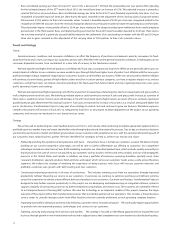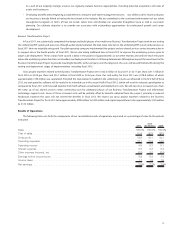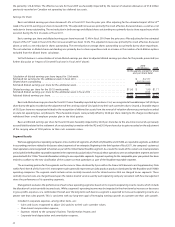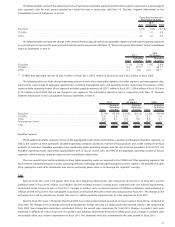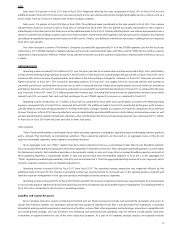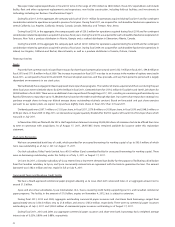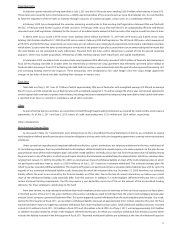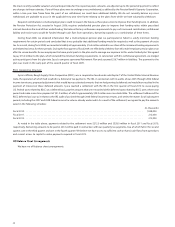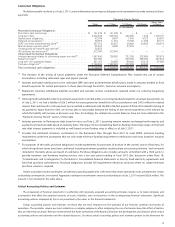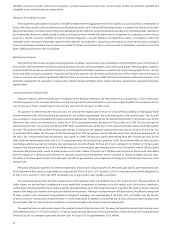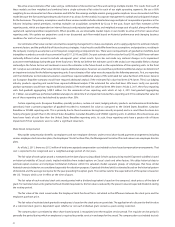Sysco 2011 Annual Report Download - page 48
Download and view the complete annual report
Please find page 48 of the 2011 Sysco annual report below. You can navigate through the pages in the report by either clicking on the pages listed below, or by using the keyword search tool below to find specific information within the annual report.business opportunities, including potential acquisitions and sales of assets and businesses, and our overall capital structure. Any transactions
resulting from these evaluations may materially impact our liquidity, borrowing capacity, leverage ratios and capital availability.
Our liquidity and capital resources can be influenced by economic trends and conditions primarily due to their impact on our cash flows from
operations. Weak economic conditions and low levels of consumer confidence and the resulting pressure on consumer disposable income can
lower our sales growth and potentially our cash flows from operations. While these factors were present in fiscal 2010 and fiscal 2011, they had
only a modest impact on our cash flows from operations in these periods due in large part to effective working capital management. We do not
believe current economic conditions will significantly impact our cash flows from operations in fiscal 2012, as we can respond to reduced
consumer demand, if it were to occur, by lowering our working capital requirements. Additionally, approximately one-third of our customers are
not impacted by general economic conditions to the same extent as restaurants and other food retailers. These customers include hospitals,
nursing homes, schools and colleges. Product cost inflation can potentially lower our gross profit and cash flow from operations if we are unable
to pass through all of the increased product costs with the same gross profit percentage to our customers. This occurred in fiscal 2011, as we were
able to pass some, but not all, of our product cost increases on to our customers. However; we believe our mechanisms to manage product cost
inflation, some of which are contractual, are sufficient to limit the impact on our cash flows from operations.
We believe that our cash flows from operations, the availability of additional capital under our existing commercial paper programs and bank
lines of credit and our ability to access capital from financial markets, including issuances of debt securities, either privately or under our shelf
registration statement filed with the Securities and Exchange Commission (SEC), will be sufficient to meet our anticipated cash requirements for
the next twelve months and beyond, while maintaining sufficient liquidity for normal operating purposes. We believe that we will continue to be
able to access the commercial paper market effectively as well as the long-term capital markets, if necessary. To further maintain and enhance our
credit ratings on current and future debt, on January 19, 2011, the wholly-owned U.S. Broadline subsidiaries of Sysco Corporation entered into full
and unconditional guarantees of all outstanding senior notes and debentures of Sysco Corporation. As of July 2, 2011, Sysco had a total of
approximately $2.2 billion in senior notes and debentures outstanding that are covered by this guarantee.
Operating Activities
We generated $1.1 billion in cash flow from operations in fiscal 2011, $0.9 billion in fiscal 2010 and $1.6 billion in fiscal 2009. The increase of
$206.1 million between fiscal 2011 and fiscal 2010 was driven largely by a reduction in the amount of payments made in relation to the IRS
settlement of $316.0 million and reduced pension contributions in the amount of $136.2 million in fiscal 2011 as compared to fiscal 2010. These
increases were partially offset by changes in working capital discussed in more detail below. The decrease of $691.3 million between fiscal 2010
and fiscal 2009 was driven largely by $528.0 million of payments related to the IRS settlement and $140.0 million of pension contributions made in
advance for fiscal 2011. Additionally, several less significant items had offsetting impacts when comparing the cash flow from operations between
fiscal 2010 and fiscal 2009. As described under “Other Considerations, BSCC Cooperative Structure,” we will make the final payments under the IRS
settlement in fiscal 2012 in the amount of $212 million.
Cash flow from operations in fiscal 2011 was primarily generated by net income, reduced by increases in receivables and inventory balances
and changes in deferred tax assets and liabilities, partially offset by non-cash depreciation and amortization expense and increases in accounts
payable. Cash flow from operations in fiscal 2010 was primarily due to net income and non-cash depreciation and amortization expense, offset by
decreases in accrued income taxes and other long-term liabilities and prepaid pension cost, net, increases in accounts receivable and inventory
balances and changes in deferred tax assets and liabilities. Cash flow from operations in fiscal 2009 was primarily due to net income, non-cash
depreciation and amortization expense, an increase in accrued income taxes, and increases in accounts receivable and inventory balances. The
increases in fiscal 2009 were partially offset by decreases in accounts payable balances and accrued expenses.
The increases in accounts receivable and inventory balances in fiscal 2011 and fiscal 2010 were primarily due to sales growth. An increase in
daily sales outstanding also contributed to the increase in accounts receivable and inventory balances in fiscal 2011. The decrease in accounts
receivable and inventory balances in fiscal 2009 was primarily due to the sales decline. The increase in accounts payable balances in fiscal 2011 and
fiscal 2010 was primarily from the growth in inventory resulting from sales growth. The decrease in accounts payable balances in fiscal 2009 was
primarily from inventory decreases resulting from the sales decline. Accounts payable balances are impacted by many factors, including changes
in product mix, cash discount terms and changes in payment terms with vendors.
Cash flow from operations was impacted by a decrease in accrued expenses of $43.3 million during fiscal 2011, an increase in accrued
expenses of $58.0 million during fiscal 2010 and a decrease in accrued expenses of $120.3 million during fiscal 2009. The decrease in accrued
expenses in the fiscal 2011 was primarily due to the payment of the respective prior year annual incentive bonuses, partially offset by lower
accruals for current year compensation incentives. The remainder of the decrease was driven by multiple changes in various other accruals, of
which no item was individually significant. The increase in accrued expenses during fiscal 2010 was primarily due to increases in incentive
compensation accruals resulting from improved operating performance in fiscal 2010. The remainder of the increase was driven by multiple
changes in various other accruals, of which no item was individually significant. The decrease in accrued expenses during fiscal 2009 was primarily
due to the payment of prior year annual incentive bonuses, offset by lower accruals for current year incentive bonuses.
Cash flow from operations for fiscal 2011 was negatively impacted by changes in deferred tax assets and liabilities of $165.2 million and a
decrease in accrued income taxes of $44.2 million. Cash flow from operations for fiscal 2010 was negatively impacted by changes in deferred tax
assets and liabilities of $121.9 million and a decrease in accrued income taxes of $296.5 million. The main factor affecting both of these changes in
fiscal 2011 and fiscal 2010, as well as cash taxes paid, was the IRS settlement (discussed below in “Other Considerations, BSCC Cooperative
24


